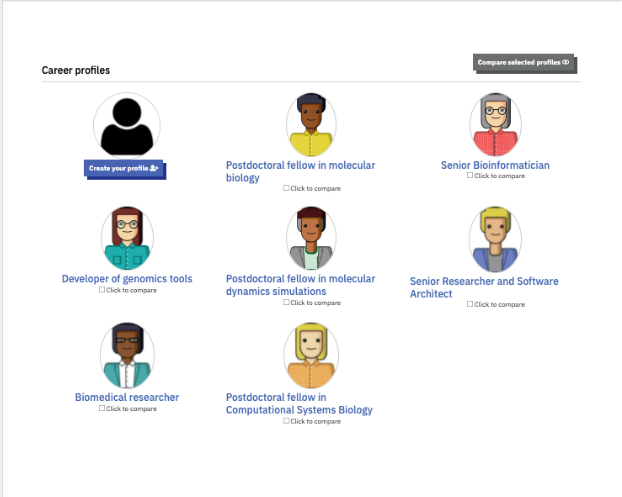| Training resource |
Associated competencies |
| Introduction to HPC for life scientists |
- Operate effectively within a Linux environment
- Use a batch job system
- Monitor application execution
- Use computational workflow systems, understanding their potential benefits and limitations
- Evaluate the ability of a program running in a specific computing environment to perform a simulation (e.g. define algorithmic time and hardware resources required to solve a problem)
|
| Course on HPC-based computational biomedicine |
- Apply expertise in medical or biomedical sciences
- Operate effectively within a Linux environment
- Use a batch job system
- Evaluate the ability of a program running in a specific computing environment to perform a simulation (e.g. define algorithmic time and hardware resources required to solve a problem)
|
| Drug studies in signalling pathways models and their integration into multiscale models |
- Follow the scientific method and proceed with all the steps in the process of solving a scientific problem
- Apply expertise in formal, natural and life sciences
- Handle data from end to end following best practice
- Apply data science expertise to clinical and life sciences problems
- Evaluate the ability of a program running in a specific computing environment to perform a simulation (e.g. define algorithmic time and hardware resources required to solve a problem)
- Write or adapt scripts and computer programs (software development) to perform simulations in compliance with good programming practice
- Use a batch job system
|
| Systematising complex and combined metabolic analyses with COBREXA.jl |
- Follow the scientific method and proceed with all the steps in the process of solving a scientific problem
- Apply expertise in formal, natural and life sciences
- Handle data from end to end following best practice
- Apply data science expertise to clinical and life sciences problems
- Evaluate the ability of a program running in a specific computing environment to perform a simulation (e.g. define algorithmic time and hardware resources required to solve a problem)
- Write or adapt scripts and computer programs (software development) to perform simulations in compliance with good programming practice
|
| From transcriptomics to mechanistic models of signalling |
- Follow the scientific method and proceed with all the steps in the process of solving a scientific problem
- Apply expertise in formal, natural and life sciences
- Handle data from end to end following best practice
- Apply data science expertise to clinical and life sciences problems
- Evaluate the ability of a program running in a specific computing environment to perform a simulation (e.g. define algorithmic time and hardware resources required to solve a problem)
- Write or adapt scripts and computer programs (software development) to perform simulations in compliance with good programming practice
|
| PerMedCoE summer school: from pathway modelling tools to cell-level simulations |
- Follow the scientific method and proceed with all the steps in the process of solving a scientific problem
- Apply expertise in medical or biomedical sciences
- Apply expertise in formal, natural and life sciences
- Handle data from end to end following best practice
- Apply data science expertise to clinical and life sciences problems
- Evaluate the ability of a program running in a specific computing environment to perform a simulation (e.g. define algorithmic time and hardware resources required to solve a problem)
- Write or adapt scripts and computer programs (software development) to perform simulations in compliance with good programming practice
- Use a batch job system
- Use computational workflow systems, understanding their potential benefits and limitations
|
| Training materials on MaBoSS |
- Follow the scientific method and proceed with all the steps in the process of solving a scientific problem
- Apply expertise in formal, natural and life sciences
- Handle data from end to end following best practice
- Apply data science expertise to clinical and life sciences problems
- Evaluate the ability of a program running in a specific computing environment to perform a simulation (e.g. define algorithmic time and hardware resources required to solve a problem)
- Write or adapt scripts and computer programs (software development) to perform simulations in compliance with good programming practice
|
|
Tutorials on COBREXA
|
- Follow the scientific method and proceed with all the steps in the process of solving a scientific problem
- Apply expertise in formal, natural and life sciences
- Handle data from end to end following best practice
- Apply data science expertise to clinical and life sciences problems
- Evaluate the ability of a program running in a specific computing environment to perform a simulation (e.g. define algorithmic time and hardware resources required to solve a problem)
- Write or adapt scripts and computer programs (software development) to perform simulations in compliance with good programming practice
|
| Tutorial on CellNOpt |
- Follow the scientific method and proceed with all the steps in the process of solving a scientific problem
- Apply expertise in formal, natural and life sciences
- Handle data from end to end following best practice
- Apply data science expertise to clinical and life sciences problems
- Evaluate the ability of a program running in a specific computing environment to perform a simulation (e.g. define algorithmic time and hardware resources required to solve a problem)
- Write or adapt scripts and computer programs (software development) to perform simulations in compliance with good programming practice
|
| Tutorial on CARNIVAL |
- Follow the scientific method and proceed with all the steps in the process of solving a scientific problem
- Apply expertise in formal, natural and life sciences
- Handle data from end to end following best practice
- Apply data science expertise to clinical and life sciences problems
- Evaluate the ability of a program running in a specific computing environment to perform a simulation (e.g. define algorithmic time and hardware resources required to solve a problem)
- Write or adapt scripts and computer programs (software development) to perform simulations in compliance with good programming practice
|
| Tutorial on how to develop Building blocks using the ‘permedcoe’ package |
- Install or deploy pre-built software on a desktop or server computer
- Package and distribute software
- Use computational workflow systems, understanding their potential benefits and limitations
|
| Information and resources on working with computing clusters |
- Handle data from end to end following best practice
- Use a batch job system
- Monitor application execution
|
| Tutorial on working with computing clusters |
|
| Introductory tutorial on using MPI with containers |
- Operate effectively within a Linux environment
- Package and distribute software
- Use a batch job system
- Write parallel programs
|
| Version control with Git |
- Handle data from end to end following best practice
- Write or adapt scripts and computer programs (software development) to perform simulations in compliance with good programming practice
- Install or deploy pre-built software on a desktop or server computer
|






